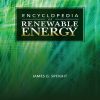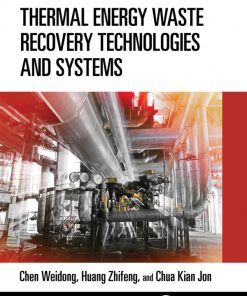Waste Heat Recovery in Process Industries 1st Edition by Hussam Jouhara ISBN 3527830006 9783527348565
$50.00 Original price was: $50.00.$25.00Current price is: $25.00.
Waste Heat Recovery in Process Industries 1st Edition by Hussam Jouhara – Ebook PDF Instant Download/Delivery: 3527830006 ,9783527348565
Full download Waste Heat Recovery in Process Industries 1st Edition after payment

Product details:
ISBN 10: 3527830006
ISBN 13: 9783527348565
Author: Hussam Jouhara
**Explore modern waste heat recovery technology across a variety of industries**
In __Waste Heat Recovery in Process Industries__, veteran thermal engineer Hussam Jouhara delivers an organized and comprehensive exploration of waste heat recovery systems with a focus on industrial applications in different temperature ranges. The author describes various waste heat recovery systems, like heat exchangers, waste heat boilers, air preheaters, direct electrical conversion devices, and thermal storage.
The book also offers discussions of the technologies and applications relevant to different temperature ranges present in industrial settings along with revealing case studies from various industries. Waste Heat Recovery in Process Industries examines a variety of industries, from steel to ceramics, chemicals, and food, and how plants operating in these sectors can use waste heat to improve their energy efficiency, reduce energy costs, and minimize their carbon footprint.
The book also offers:
* A thorough introduction to waste heat recovery systems, including recuperative and regenerative burners, heat exchangers, waste heat boilers, air preheaters, and heat pumps
* Comprehensive explorations of low temperature applications, below 100°C, including advantages and drawbacks, as well as illustrative case studies
* Practical discussions of medium temperature applications, between 100°C and 400°C, including case studies
* In-depth examination of high temperature applications, above 400°C, including several case studies
Perfect for chemical, process, and power engineers, __Waste Heat Recovery in Process Industries__ is also an ideal resource for professionals working in the chemical, metal processing, pharmaceutical, and food industries.
Waste Heat Recovery in Process Industries 1st Edition Table of contents:
Chapter 1 Thermodynamic Cycles
1.1 Introduction to Thermodynamic Cycles
1.2 Rankine Cycle
1.2.1 Introduction
1.2.2 Thermodynamic Diagrams
1.2.3 The Carnot Cycle
1.2.4 Ideal and Actual Rankine Cycles
1.2.4.1 Ideal Cycle
1.2.4.2 Superheated Rankine Cycle
1.2.4.3 Actual Rankine Cycle
1.2.4.4 Improvements to the Rankine Cycle
1.2.4.5 Regenerative Rankine Cycles
1.2.4.6 Cogeneration
1.2.5 Other Configurations of the Rankine Cycle
1.2.5.1 Supercritical Rankine Cycles
1.2.5.2 Reverse Rankine Cycles
1.2.6 Rankine Cycles in Power Plants
1.2.6.1 Fossil Fuel Power Plants
1.2.6.2 Nuclear Power Plants
1.2.6.3 Overall Efficiency of a Power Plant
1.2.6.4 Case Studies
1.3 Organic Rankine Cycle
1.3.1 Configurations of ORC
1.3.1.1 Basic ORC Configuration
1.3.1.2 ORC with Preheating
1.3.1.3 Recuperative ORC
1.3.1.4 Recuperative ORC with Preheating
1.3.2 Organic Working Fluids
1.3.3 Organic Working Fluid Selection
1.3.4 Applications of the ORC
1.3.4.1 Waste Heat Recovery
1.4 Kalina Cycle
1.4.1 Cycle Fundamentals
1.4.1.1 Why Use Ammonia–Water Solution in Kalina Cycle?
1.4.2 Advantages and Drawbacks
1.4.2.1 Advantages
1.4.2.2 Drawbacks
1.4.3 Applications of the Kalina Cycle
1.4.3.1 The Different Configurations of the Cycle
1.4.4 Case Studies
1.5 Brayton Cycle
1.5.1 Regenerative Brayton Cycle (Regenerator)
1.5.1.1 Compressor Analysis
1.5.1.2 Turbine Analysis
1.5.1.3 Heat Supplied to the Cycle
1.5.2 Regenerative Brayton Cycle (Reheater and Intercooler)
1.5.2.1 Intercooling
1.5.2.2 Reheating
1.6 Chapter Summary
References
Chapter 2 Waste Heat Recovery
2.1 Burner and Air Preheaters
2.1.1 Recuperators
2.1.1.1 Recuperative Burners
2.1.1.2 Classifying Recuperative Burners
2.1.1.3 Efficiency Improvement and Fuel Savings
2.1.2 Regenerators
2.1.2.1 Rotary Regenerators
2.1.2.2 Static Regenerators
2.1.2.3 Regenerative Burners
2.1.3 Burner Technology Comparison
2.1.4 NOx Formation
2.1.5 Run‐Around Coil
2.2 Heat Exchangers
2.2.1 Shell and Tube HEXs
2.2.1.1 Construction
2.2.1.2 Applications and Limitations
2.2.2 Plate Heat Exchanger
2.2.2.1 Spiral Plate Heat Exchanger
2.2.3 Heat Pipe Heat Exchanger
2.2.4 Compact HEX
2.3 Waste Heat Boilers
2.3.1 Different WHB Designs
2.3.2 WHB Methodologies
2.3.2.1 Feed Water Preheating Effect
2.3.2.2 Optimising Thermodynamic Cycles
2.3.2.3 Heat Recovery Boiler with Water Spray Systems
2.3.3 Failure Modes
2.3.3.1 Failure Modes Analysis
2.4 Heat Recovery Steam Generators
2.4.1 Construction of Waste HRSG
2.4.1.1 HRSG Design and Construction
2.4.1.2 Evaporator
2.4.1.3 Superheater
2.4.1.4 Economiser
2.4.1.5 Steam Drum
2.4.1.6 Evaporator Types
2.4.1.7 Horizontal Tube HEXs
2.4.1.8 Natural Circulation HRSGs
2.4.1.9 Assisted (or Forced) Circulation HRSGs
2.4.1.10 Tube Materials
2.4.1.11 The ‘Pinch Point’ and Other Effects
2.5 Heat Pumps
2.5.1 Fundamental Principles of Heat Pumps
2.5.1.1 Cooling Mode
2.5.1.2 Heating Mode
2.5.2 Variation of Heat Pump System
2.5.2.1 Air Source Heat Pump System
2.5.2.2 Ground Source Heat Pump System
2.5.2.3 Water Source Heat Pump System
2.5.2.4 Water Loop Heat Pump System
2.5.2.5 Exhaust Air System
2.5.2.6 Hybrid Heat Pump
2.5.2.7 Solar‐Assisted Heat Pumps
2.6 Direct Electrical Conversion Device
2.6.1 TEG – Working Principle
2.6.2 The Seebeck Effect
2.6.3 The Peltier Effect
2.6.3.1 Applications of the Peltier Effect
2.6.4 Thomson Effect
2.6.5 Joule Heating
2.6.6 Theoretical Principle
2.6.7 Figure of Merit
2.6.8 Fermi Level
2.6.9 Nano‐Sizing
2.6.10 Efficiency of TEG
2.7 Thermal Storage
2.7.1 Sensible Heat Storage
2.7.2 Latent Heat Storage
2.7.3 Thermochemical Storage
2.7.4 Phase Change Materials
2.7.5 Organic Material
2.7.6 Inorganic PCMs
2.7.7 Eutectic PCMs
2.7.8 PCM Methodologies
2.7.8.1 Encapsulation of PCMs
2.7.8.2 Microencapsulated PCMs
2.7.8.3 Macroencapsulation of the PCMs
2.7.8.4 Nanomaterial PCMs
2.7.8.5 Shape Stabilisation
2.8 Design Development Methods
2.8.1 Introduction
2.8.2 Heat Exchangers
2.8.2.1 Local Heat Transfer
2.8.2.2 LMTD Method
2.8.2.3 Effectiveness‐Number of Transfer Units (ε‐NTU) Method
2.8.3 Regenerative and Recuperative Burners
2.8.3.1 Regenerative Burners
2.8.3.2 Recuperative Burners
2.8.4 Waste Heat Boilers
2.8.5 Air Preheaters
2.8.6 Heat Recovery Steam Generator
2.8.7 Heat Pumps
2.8.8 Direct Electrical Conversion Device
2.8.9 Thermal Storage
References
Chapter 3 Low‐Temperature Applications
3.1 Refrigeration
3.2 Cryogenics
3.2.1 Loop Heat Pipe
3.3 HVAC
References
Chapter 4 Medium‐Temperature Applications
4.1 Food Industry
4.1.1 Energy Use in the Industry
4.1.2 Case Study 1: Heat Recovery Potential of the Crisps Manufacturing Process
4.1.3 Case Study 2: Temperature and Energy Performance of Open Refrigerated Display Cabinets Using Heat Pipe Shelves
4.2 Ventilation
4.2.1 Applications
4.3 Solar Energy
4.4 Geothermal Energy
4.5 Automotive Industry
4.5.1 Industrial Processes
4.6 Aviation
References
Chapter 5 High‐Temperature Applications
5.1 Steel Industry
5.1.1 TEG Modules
5.1.2 Heat Exchangers
5.1.2.1 Application 1: Slag Particles Blast Furnace Retrofit
5.1.2.2 Application 2: Flat Heat Pipe Heat Exchanger
5.1.3 Recuperators
5.1.3.1 Application 1: Heat Recuperator for Steel Slag
5.2 Ceramic Industry
5.2.1 Introduction
5.2.2 Heat Exchangers
5.2.2.1 Application 1: Radiative Heat Pipe
5.2.2.2 Application 2: Multi‐Pass Heat Pipe
5.2.2.3 Application 3: Forced Convection Heat Pipe
5.3 Cement Industry
5.3.1 Gas Suspension Preheaters
5.3.1.1 Application 1
5.3.1.2 Application 2
5.3.2 Heat Pipe Thermoelectric Generator
5.4 Aluminium Industry
5.4.1 Rotary Regenerator
5.4.2 Heat Exchangers
5.4.3 Heat Pumps
5.4.4 Recuperators
5.4.4.1 Radiative Recuperator
5.4.4.2 Convective Recuperator
5.4.4.3 Hybrid Recuperator
5.4.5 Thermoelectric Device
5.4.6 Regenerative Burner
5.4.7 Preheating Scrap
5.4.8 De‐coating
References
Index
People also search for Waste Heat Recovery in Process Industries 1st Edition:
waste heat recovery examples
waste heat recovery methods
waste heat recovery companies
waste heat from industrial processes
waste heat recovery technologies
Tags: Hussam Jouhara, Waste Heat Recovery, Process Industries
You may also like…
Engineering - Civil & Structural Engineering
Engineering - Environmental
Waste Management in the Fashion and Textile Industries 1st Edition Rajkishore Nayak
Engineering - Environmental
Biology and other natural sciences - Plants: Agriculture and Forestry
Technique - Food Manufacturing











